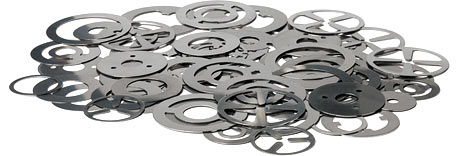
Tables and diagrams may present strong arguments, but nothing compares to hearing how our shock absorber strip steel does in reality. This is what one of our customers says about Alleima strip steel for shock absorber shims.
 Magnus Danek, Manager R&D and Racing at Öhlins, Sweden
Magnus Danek, Manager R&D and Racing at Öhlins, Sweden
So far only we has succeeded in satisfying our requirements
For more than 30 years, Öhlins has been manufacturing shock absorbers for various sports cars and is now market leader in the fields of racing, rally, road racing and motocross. Öhlins' strong reputation on the race track means that its bright yellow springs can now be seen on high-end road cars such as Lotus and Pagani Zonda.
Stringent tolerance requirements
The shims are at the heart of the shock absorbers themselves, and Öhlins imposes extremely stringent tolerance requirements to ensure that all the shock absorbers on a single vehicle behave identically. In terms of thickness, the specified tolerance is T4, which means that a shim with a thickness of 0.200 mm (0.00787 in.) must have a maximum variation of plus or minus four thousandths of a millimeter!
We have tried several shock absorber steel suppliers throughout the years, but so far only Alleima has succeeded in satisfying our requirements
, explains Magnus Danek, Head of R&D and Racing, Automotive, Öhlins, Sweden.
Having spent 18 years at Öhlins, Danek knows how important it is for theory and practice to go hand in hand.
Even if you have the best project engineer in the world, no model alone can tell you how a vehicle will behave when it hits a specific pothole in a dirt track or in a sand dune out in the desert
, he says.
Reduction of number of shims
Practical tests must be carried out on the road or track before the final product goes to market.
If I go out to a forest, for example, to test shock absorption in a rally car, I must be able to rely on the shim thickness being correct. A hundredth of a millimeter either way can cause leakage, which in turn can affect road holding and safety.
However, bearing in mind that a component as important as the shims represents such a small part of the shock absorber's total cost, Öhlins sees no reason to choose an inferior steel.
On the contrary
, says Danek, a good steel with close tolerances gives us scope to increase or decrease the number of shims in the stack as required, without compromising on quality.